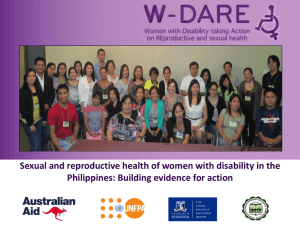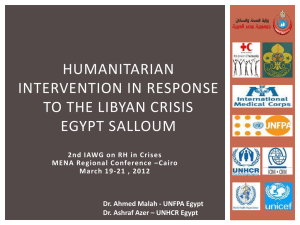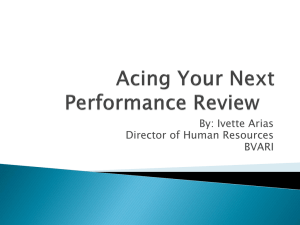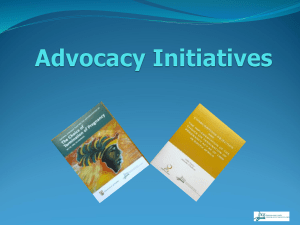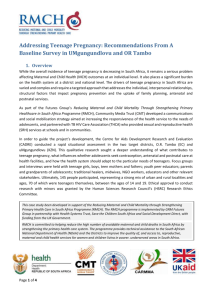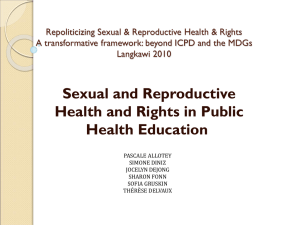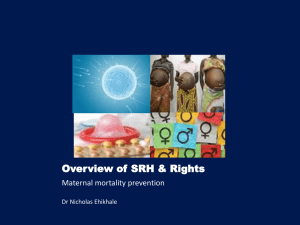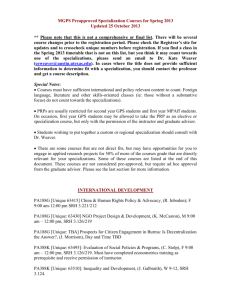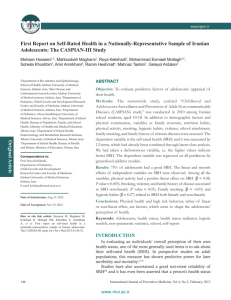Answer to reviewer`s report 1 Title: "Self-rated health"
advertisement
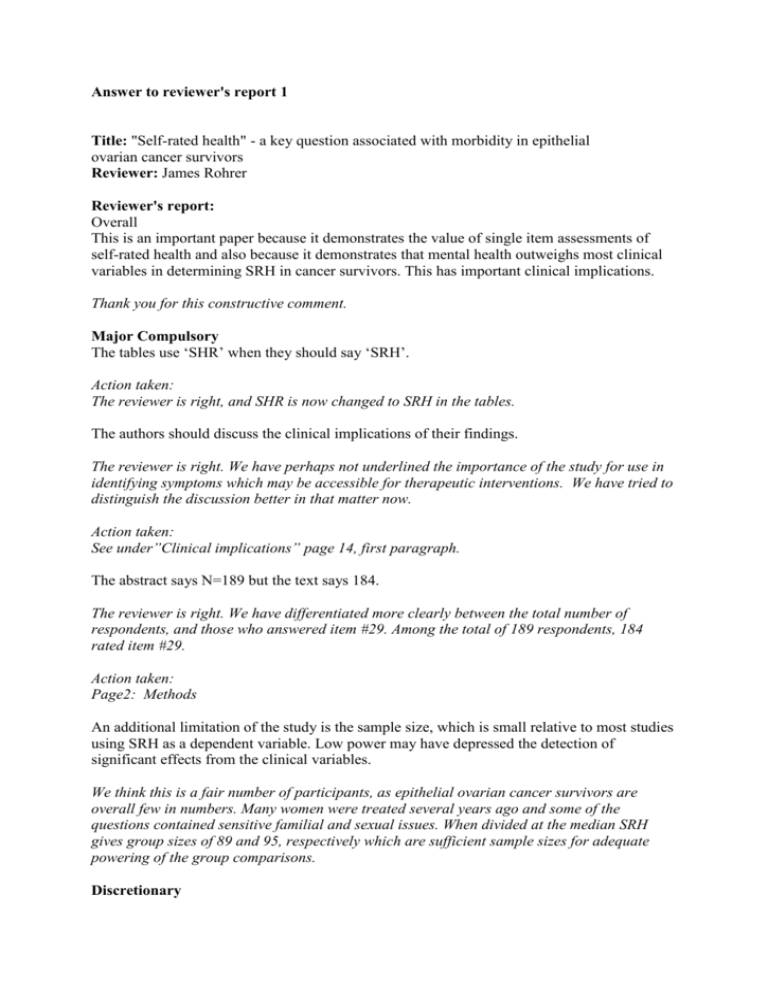
Answer to reviewer's report 1 Title: "Self-rated health" - a key question associated with morbidity in epithelial ovarian cancer survivors Reviewer: James Rohrer Reviewer's report: Overall This is an important paper because it demonstrates the value of single item assessments of self-rated health and also because it demonstrates that mental health outweighs most clinical variables in determining SRH in cancer survivors. This has important clinical implications. Thank you for this constructive comment. Major Compulsory The tables use ‘SHR’ when they should say ‘SRH’. Action taken: The reviewer is right, and SHR is now changed to SRH in the tables. The authors should discuss the clinical implications of their findings. The reviewer is right. We have perhaps not underlined the importance of the study for use in identifying symptoms which may be accessible for therapeutic interventions. We have tried to distinguish the discussion better in that matter now. Action taken: See under”Clinical implications” page 14, first paragraph. The abstract says N=189 but the text says 184. The reviewer is right. We have differentiated more clearly between the total number of respondents, and those who answered item #29. Among the total of 189 respondents, 184 rated item #29. Action taken: Page2: Methods An additional limitation of the study is the sample size, which is small relative to most studies using SRH as a dependent variable. Low power may have depressed the detection of significant effects from the clinical variables. We think this is a fair number of participants, as epithelial ovarian cancer survivors are overall few in numbers. Many women were treated several years ago and some of the questions contained sensitive familial and sexual issues. When divided at the median SRH gives group sizes of 89 and 95, respectively which are sufficient sample sizes for adequate powering of the group comparisons. Discretionary The first set of tables presents independent variable means and proportions cross-classified into good or poor SRH. However, the multiple regression analysis uses SRH in its continuous formulation. Since SRH usually is analyzed as good versus poor, I suggest that multiple logistic regression analysis be employed instead of OLS. See examples in the bibliographies of the articles listed below. 1. Marital status, feeling depressed and self-rated health in rural female primary care patients. Rohrer JE, Bernard ME, Zhang Y, Rasmussen NH, Woroncow H J Eval Clin Pract 2008 Apr, 14:214-7 2. Overall self-rated health as an outcome indicator in primary care. Rohrer JE, Arif A, Denison A, Young R, Adamson S. J Eval Clin Pract 2007 Dec, 13:882-8 3. Physical limitations and self-rated overall health in family medicine patients. Rohrer JE, Merry SP, Rohland B, Rasmussen N, Wilshusen L. Clin Rehabil 2008 Jan, 22:38-44 4. A patient-centered decision rule for referral of patients to weight-loss programs. Rohrer JE, Merry SP, Lopez-Jimenez F, Adamson SC, Wilshusen L. Qual Manag Health Care 2007 Jul-Sep, 16:250-5 Thank you for interesting references with very relevant information. Especially paper 2 supports our conclusions and our discussionof using a single–item measure of self-rated health to identify symptoms which may be accessible for therapeutic intervention. We have included: Overall self-rated health as an outcome indicator in primary care. Rohrer JE, Arif A, Denison A, Young R, Adamson S. J Eval Clin Pract 2007 Dec, 13:882-8 as reference17 and in the text page 4 and14. Action taken: Page 14, first paragraph: Clinical implications. If the authors insist on using stepwise methods, showing the final model is sufficient rather than each step. Confidence intervals should be presented in the tables and the text. The authors discuss use of the median value to dichotomize SRH, but most studies end up with 80% in the ‘good’ category, because ordinal single-items (excellent, very good, good, fair and poor) are the basis of the scale. Action taken: We are thankful for the reviewer’s comment. As the reviewer indicates there are several considerations to be made in the selection of multivariate models. The reviewer’s comment seems pertinent to a 4 step ordinal item of self-rated health. However, item #29 of the EORTC QLQ-C30 has 7 steps from 1 (very poor) to 7 (excellent). Sevens steps in our view prohibits multinominal logistic regression analysis due to the need of presenting of the results of six levels related to the reference level. We have followed the reviewer’s advice of just showing the final model of the stepwise analysis. We have included confidence intervals in the text as suggested. Answer Reviewer’s report 2 Title: "Self-rated health" - a key question associated with morbidity in epithelial ovarian cancer survivors Reviewer: Niels Rasmussen Reviewer's report: The paper presents an interesting analysis of self-rated health (SRH) among epithelial ovarian cancer survivors (EOCS), and concludes that the level of SRH among these patients is not different from the level in a group of matched controls. The data were collected in a cross sectional design. In order to have relatively large sample patients who had been diagnosed during the last 29 years were included in the study. The most important predictor of poor self-rated health among the patients were somatic symptoms, whereas SRH were not associated with cancer related variables. The paper concludes that Systematic use of this question may be helpful for the clinicians as a quick screening for eventual therapeutic interventions in EOCS. The study is very interesting in it set up as it contributes to the understanding of what constitutes SRH – how should it be interpreted. The study is well conducted, although it is not analysed or discussed thoroughly what effect the variation in the follow up period might have had on the responses or self-ratings among the patients. It is not easy to imagine what type of bias could be introduced, but at least the length of the period could have been introduced in the multivariate model to see whether there was an effect. Action taken: Thank you for the constructive comments. Action taken: In Table 1, we present the finding of no significant differences in follow-up time between those with “Good SRH” and those with” Poor SHR”. Because of this non-significant finding, follow-up time was not entered into the multivariate model. In a recalculation we have done so, but follow-up time does not make a significant contribution to the model. It is interesting how little the level of SRH differs between the patients and the controls, and the authors refer to the notion of “response shift”, explained as how individuals integrate changes in their health state so that their internal standards, values, or concepts of quality of life are nearly unchanged from before. This could be claimed as an indication of poor validity and stability of the measure. Action taken: The reviewer is right. We have therefore moved the paragraph discussing response shift to the “Strength and limitation” section in the Discussion, page 14, third paragraph. However no significant differences in the overall distribution of the SRH scores between the EOCSs and NORM were observed, a higher proportion of controls recorded a SRH score of 100 (p<.02) (Figure 1). This indicates an important difference indeed. Also the finding that the measure do not associate with the cancer related variables is an indication that the measure is not specific for the type health problems in the group of patients. It makes it difficult to understand the authors’ conclusion that SRH might be helpful for the clinician as a quick screening for eventual therapeutic interventions. To the reviewer the results points to the opposite conclusion, that SRH has no specific clinical relevance. We understand the reviewer’s point of view here. However, the EORTC QLQ-C30 is a cancer specific quality of life instrument which is in much use and very accepted within the research community of clinical oncology. So its validity in the study of cancer patients has been demonstrated. It is a major finding of our study that SRH is not associated with treatment variables. We have formerly reported the same lack of association in relation to fatigue and sexual function in our sample. (Liavaag AH, Dørum A, Fosså SD, Tropé C, Dahl AA. Controlled study of fatigue, quality of life, somatic and mental health in epithelial ovarian cancer survivors. “How lucky are the lucky ones?” J Clin Oncol 2007;25:2049-56. Liavaag AH, Dørum A, Bjøro T, Oksefjell H, Fosså SD, Tropé C, Dahl AA. A controlled study of sexual activity and functioning in epithelial ovarian cancer survivors: a therapeutic approach. Gynecol Oncol 2008; 108:348-54).
